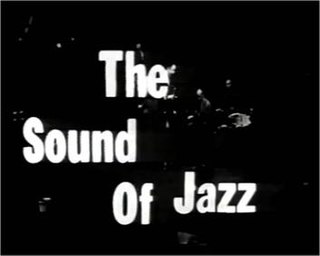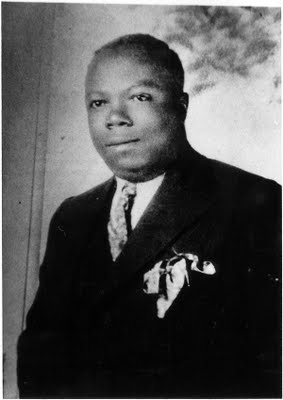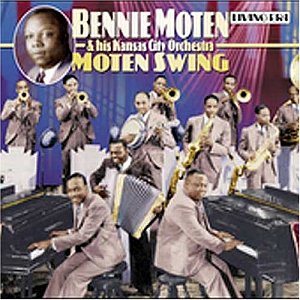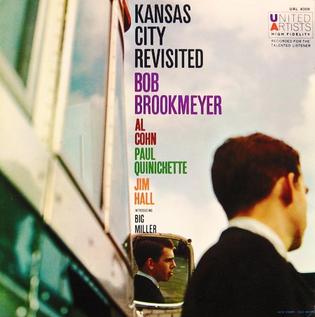Related Research Articles

William James "Count" Basie was an American jazz pianist, organist, bandleader, and composer. In 1935, he formed the Count Basie Orchestra, and in 1936 took them to Chicago for a long engagement and their first recording. He led the group for almost 50 years, creating innovations like the use of two "split" tenor saxophones, emphasizing the rhythm section, riffing with a big band, using arrangers to broaden their sound, and others. Many musicians came to prominence under his direction, including the tenor saxophonists Lester Young and Herschel Evans, the guitarist Freddie Green, trumpeters Buck Clayton and Harry "Sweets" Edison, plunger trombonist Al Grey, and singers Jimmy Rushing, Helen Humes, Thelma Carpenter, and Joe Williams.

James Andrew Rushing was an American singer and pianist from Oklahoma City, Oklahoma, U.S., best known as the featured vocalist of Count Basie's Orchestra from 1935 to 1948.

Oran Thaddeus "Hot Lips" Page was an American jazz trumpeter, singer, and bandleader. He was known as a scorching soloist and powerful vocalist.

"The Sound of Jazz" is a 1957 edition of the CBS television series The Seven Lively Arts and was one of the first major programs featuring jazz to air on American network television.

Benjamin Moten was an American jazz pianist and band leader born and raised in Kansas City, Missouri, United States.

The Count Basie Orchestra is a 16 to 18 piece big band, one of the most prominent jazz performing groups of the swing era, founded by Count Basie in 1935 and recording regularly from 1936. Despite a brief disbandment at the beginning of the 1950s, the band survived long past the Big Band era itself and the death of Basie in 1984. It continues under the direction of trumpeter Scotty Barnhart.
Walter Sylvester Page was an American jazz multi-instrumentalist and bandleader, best known for his groundbreaking work as a double bass player with Walter Page's Blue Devils and the Count Basie Orchestra.

Kansas City jazz is a style of jazz that developed in Kansas City, Missouri during the 1920s and 1930s, which marked the transition from the structured big band style to the much more improvisational style of bebop. The hard-swinging, bluesy transition style is bracketed by Count Basie, who in 1929 signed with Bennie Moten's Kansas City Orchestra, and Kansas City native Charlie Parker, who ushered in the bebop style in America. It has been said that while New Orleans was the birthplace of jazz, "America's music" grew up in Kansas City.
Henry Franklin "Buster" Smith, also known as Professor Smith, was an American jazz alto saxophonist and mentor to Charlie Parker. Smith was instrumental in instituting the Texas Sax Sound with Count Basie and Lester Young in the 1930s.

Herschel "Tex" Evans was an American tenor saxophonist who was a member of the Count Basie Orchestra. He also worked with Lionel Hampton and Buck Clayton. He is also known for starting his cousin Joe McQueen's interest in the saxophone. Joe McQueen, living until 2019 at age 100, may well have been the last surviving person to have known Herschel during his lifetime.
Edward Durham was an American jazz guitarist, trombonist, composer, and arranger. He was one of the pioneers of the electric guitar in jazz. The orchestras of Bennie Moten, Jimmie Lunceford, Count Basie, and Glenn Miller took great benefit from his composing and arranging skill.
Territory bands were dance bands that crisscrossed specific regions of the United States from the 1920s through the 1960s. Beginning in the 1920s, the bands typically had 8 to 12 musicians. These bands typically played one-nighters, six or seven nights a week at venues like VFW halls, Elks Lodges, Lions Clubs, hotel ballrooms, and the like. Francis Davis, jazz critic for The Village Voice, likened territory bands to "the Top 40 cover bands of their day, typically relying on stock arrangements of other ensembles' hits." He said, "many historians give much credit to territory bands for popularizing modern ballroom dancing that began during the World War I era with the influence of Vernon and Irene Castle."
Gene Ramey was an American jazz double bassist.
Ed Lewis was an American jazz trumpeter.
Ronald "Jack" Washington was an American jazz saxophonist who was a member of the Count Basie orchestra in the 1930s and 1940s.
The Last of the Blue Devils, subtitled The Kansas City Jazz Story, is a 1979 film documentary with notable figures from the history of Kansas City jazz starring Count Basie and Big Joe Turner. The film was produced and directed by Bruce Ricker.

"Moten Swing" is a 1932 jazz standard by Bennie Moten and his Kansas City Orchestra. It was an important jazz standard in the move towards a freer form of orchestral jazz and the development of Swing music. Moten and his Orchestra, which included Count Basie on piano, achieved much success with it, although the song is most associated with Basie's Count Basie Orchestra, who recorded it in 1940.
The Pearl Theatre was a theatre in Philadelphia. Opened in 1927 with 1400 seats, it was a notable jazz and dance venue and had a glamorous reputation among the rich and famous. In 1931, the Nicholas Brothers played here. Duke Ellington, John Coltrane, and many other prominent jazz ensembles of the period performed here. Bennie Moten and the Kansas City Stompers's featuring Count Basie on piano performed at the club in November 1931, and in December 1932 the audience raved all week about their "Moten Swing"; the doors of the theatre were let open to the public who came crammed into the theatre to hear the new sound, demanding seven encores on one night. Pearl Bailey was discovered at the theatre, where she entered and won the theatre's amateur song and dance contest and was to be paid $35 a week to perform there for two weeks, however, the theatre closed during her engagement and she was never paid.

Count Basie Story is a double album by pianist, composer and bandleader Count Basie featuring tracks originally performed by his orchestra in the 1930s and 1940s rerecorded in 1960 as a celebration of its 25th anniversary and first released on the Roulette label. Selections from the 2-LP set were also released as Roulette's The Best of Basie in 1962 and The Best of Basie Vol. 2 in 1964. The album was rereleased with bonus tracks in 2004 to commemorate Basie's 100th birthday.

Kansas City Revisited is an album by jazz trombonist and arranger Bob Brookmeyer featuring Brookmeyer's new orchestrations of 1920s and '30s era Kansas City jazz tunes. The album was recorded in 1958 for the United Artists label.
References
- ↑ Russell, Bird Lives, p. 59: "Before attaining his majority Lester was recruited by the barnstorming Oklahoma City Blue Devils, the scourge of every band in the Southwest. The Blue Devils thrived on battles of the bands. Their reed section smothered rivals under an overwhelming torrent of sound. They were masters of the riff style. Each section bristled with solo talent. They had taken on and beaten the best bands from Kansas City, even Bennie Moten. Had not the Depression intervened, no other band could have touched them. Beginning in 1930 one star after another had left the blue Devils—Basie, Lips Page, Walter Page, Eddie Durham, Jimmy Rushing—all of them to seek employment in Pendergast's Depression-proof Kansas City."
- ↑ Wishart, Encyclopedia of the Great Plains, p. 531: "Buster Smith's troop began in Dallas before relocating and gaining fame as the Oklahoma City Blue Devils. This legendary group included Walter Page on Bass, the Influential Lester Young on tenor saxophone, blues shouter Jimmy Rushing, and the great Bill 'Count' Basie on the piano."
- ↑ Hentoff, Listen to the Stories, p. 205: "Many of the musicians at the two gatherings that make up the film were once associated with the Oklahoma City Blue Devils, a powerfully rolling unit started by bassist Walter Page in the 1920s. It was the first big band Count Basie had ever been in. Other alumni have included Lester Young, Jo Jones, Jimmy Rushing, and Buster Smith. Page took the name of the band from the intrepid barbed-wire cutters during the range wars between farmers and cattlemen."
- ↑ Wolfgang, "The Early Days": " 'Fence wars' began breaking out in 1882-1883. Many times individuals and even organizations of fence cutters with monikers such as the Owls, Blue Devils and Javelinas, cut miles of fence on the midnight rides."
- ↑ Dinerstein, Swinging the Machine, p. 107: "Ellison grew up in Oklahoma City, the home-base of the influential territory band, the Oklahoma City Blue Devils; he was also a close personal friend of Jimmy Rushing, the band's vocalist, and a regular at their performances and jam sessions. Anchored by the bassist Walter Page, the trumpeter Oran "Hot Lips" Page, Rushing, and the tenor saxophonist Lester Young, the Blue Devils effectively merged with Bennie Moten's band in Kansas City between 1932 and 1935 to form the Count Basie Band."